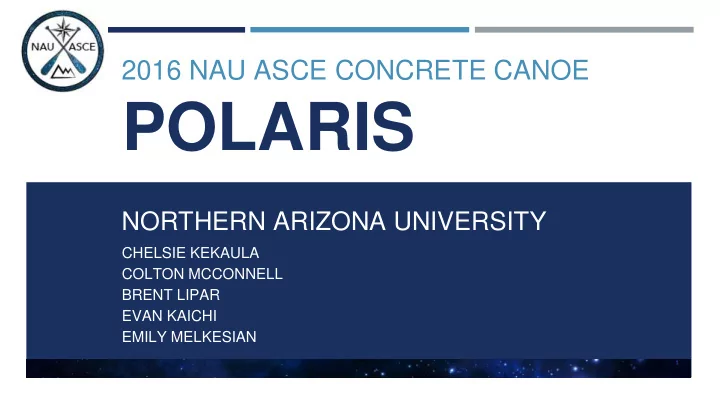

2016 NAU ASCE CONCRETE CANOE POLARIS NORTHERN ARIZONA UNIVERSITY CHELSIE KEKAULA COLTON MCCONNELL BRENT LIPAR EVAN KAICHI EMILY MELKESIAN 1
Project Description Design and construct a concrete canoe • Maximum length/width: 22 feet/3 feet • Minimum reinforcement percent open area: 40% • No stain or paint • Participate in ASCE Pacific Southwest Conference (PSWC) • Judged on technical paper, oral presentation, final product, • paddling races Galaxy theme • Figure 1: 2016 Concrete Canoe POLARIS 2
Hull Design Hull Design • Maximum Length: 21 ft • Maximum Width: 27 in (2 ft-3 in) • Maximum Depth: 14 in (1 ft-2 in) • Uniform Thickness: 0.5 in • Figure 2: Prolines Software Model Figure 3: Longitudinal Cross Section POLARIS 3
Hull Analysis Improvements: • Linear relationship to cubic function Calculated Waterlines: • Fully Submersed: 0.2 in • 4-Person: 6.9 in • 2-Men: 8.5 in • 2-Women: 9 in 4 Figure 4: Buoyant Force vs. Waterline Comparison
Structural Analysis Structural Analysis • Hull Capacity vs Demand: • 1”x1”x.5” Panels: 1715.9 psi (425.24 psi) • WT-Shape Ribs: 5290.6 psi (425.24 psi) • Transverse Cross-Section: • Figure 5: Longitudinal Moment Comparison Tension Face: 917.5 psi (145.7 psi) • Compression Face: 1319.5 psi (151.7 psi) • POLARIS Figure 6: Transverse Moment Comparison 5
Concrete Mix Design Concrete Constituents (% volume) Table 1: Structural Mix Properties Dry Unit Weight 59 pcf (<62.4 pcf) EkkoMaxx Fly Ash: 21.2% • 28-day Compressive Strength 1950 psi Poraver (0.5-1mm): 36.0% • 28-day Tensile Strength 190 psi 3M Glass Bubbles (K20 & S32): 23.7% • 28-day Flexural Strength 1230 psi BASF Black Liquid Pigment: 2.9% • MB AE 90 Air Entrainer: 0.1% • Water: 10.5% • Additives: 5.6% • BASF Master Fibers • Figure 9: Flexural Test Figure 7: Compression Test Figure 8: Tensile Test POLARIS 6
Reinforcement Selected primary reinforcement from five • different materials Table 2: Reinforcement Alternatives Strength and elongation • Material SpiderLath Dryvit TriAx Geogrid Parex Glass Fiber Glasgrid Pavement SpiderLath Fiberglass Mesh • Fiberglass Reinforcing Reinforcing Mesh [9] Reinforcing System [8] Mesh [6] Mesh [7] [10] Tensile Strength: 756 lb. • Elongation: 0.25 in • Percent Open Area: 62.6% • Strength (lb) 756 102 72 135 181 Elongation (in) 0.25 .07 0.62 .08 .04 POLARIS 7
Reinforcement Overlap Created composite samples of • reinforcement and concrete Represented placement of reinforcement • in canoe Tested overlap lengths of 2 in., 4 in., and 6 • in. All overlap lengths worked • Figure 11: Overlap Test Figure 10: Overlap Samples Chose 4 in. to be conservative • Figure 12: Reinforcement Placement 8 POLARIS
Post-Tensioning System composed of six 1/16’’ galvanized steel • cables placed symmetrically about the centroid Cables tensioned to 95 lbs., resulting in 57 lbs. • of tension after losses Total axial compression: 342 lbs. • Figure 13: Post Tensioning System Aids in reducing large cracks • Figure 15: Post Tensioning Canoe Figure 14: Anchorage System POLARIS 9
Canoe Pour and Curing Figure 16: Spray 1/8” Concrete onto Mold Figure 18: Apply Post-Tensioning Figure 17: Apply Reinforcement over Ribs & Center Figure 21: Construct Curing Structure Figure 19: Apply Reinforcement Figure 22: Moisture Cure for 21-days Figure 20: Trowel Final Layer of Concrete 10 POLARIS
Finishing Figure 23: Dry Sand Canoe Figure 24: Wet Sand Canoe Figure 25: Carve and Etch Concrete Figure 26: Seal Canoe 11 POLARIS
Final Product Figure 27: Completed Ribs Figure 28: Stern Design Figure 29: 3D Element Figure 30: Bow Design POLARIS 12
Conference Results 6th place overall finish • 3rd place for design paper • 4th place for final product • 13 th place for racing • 15 th place for oral presentation • Figure 31: Canoe at Conference 13 Figure 32: Team Photo Figure 33: Conference Display Figure 34: Canoe Cutaway Section
Schedule Table 3: Scheduled versus Actual Completion Date Key 14
Cost Table 4: Actual Cost of Engineering Services Saved almost $6,000 ● ~ $4,000 in Personnel ● ~ $1,000 in Travel ● ~ $1,000 in Expenditures 15
Impacts Institutional Impacts Provides civil engineering students hands-on practical experience and improves leadership skills • Knowledge and lessons learned for future NAU teams • NAU Civil Engineering Department • Broader Impacts Use of CeraTech’s EkkoMaxx cement – 100% sustainable material • Increases awareness among students, educators, and professionals of concrete technology and • innovation 16
Acknowledgements Mark Lamer Melkesian Family Thomas Nelson Kaichi Family Gary Slim Tommy Perkins Robin Tuchscher Jeremy DeGeyter Chris Hazel Cynthia Alvarez Gina Boschetto Henry and Glenna Wong Dillion Corrington Hank and Merle Miyamoto Stephanie Crocker Zach Crimmins Hudson & Ann Kekaula Paige Reilly Kaipo Kekaula Ian Connair Jimmie McConnell Brando Gutierrez Wendy McConnell POLARIS 17
References [1] ASTM (2004). “ Compressive Strength of Cylindrical Concrete Specimens”, C 39/C 39M -01, West Conshohocken, PA. [2] ASTM (2011). “ Standard Performance Specification for Hydraulic Cement.” C1157/C1157M -11, West Conshohocken, PA. [3] ASTM (2010). “ Standard Specification for Fiber- Reinforced Concrete.” C1116/C1116M -10a, West Conshohocken, PA. [4] ASTM (2016). “ Standard Test Method for Flexural Strength of Concrete (Using Simple Beam with Third-Point Loading )”, C78 / C78M- 15b, West Conshohocken, PA. [5] CeraTech (2012). CeraTech EkkoMAXX ™ : General Product Information and Specifications. URL: http://www.ceratechinc.com/Content /PDFs/ekkomaxx%20Green%20Concrete%20MSDS.pdf> (Sep. 9, 2015). Web. [6] SpiderLath URL:http://compositesandarchitecture.com/?p=3212 [7] Photo taken by 2014-2015 Concrete Canoe Team [8] Photo taken by 2014-2015 Concrete Canoe Team [9] Photo taken by 2014-2015 Concrete Canoe Team [10] Photo taken by 2014-2015 Concrete Canoe Team 18
THANK YOU Presenting: POLARIS 19
Recommend
More recommend